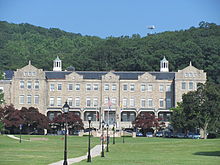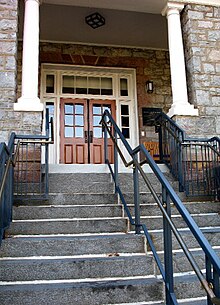Mount St. Mary's University, also known as The Mount, is a private, liberal arts, Catholic university in the Catoctin Mountains near Emmitsburg, Maryland. It was founded by French émigré Father John DuBois in 1808 and is the oldest independent Catholic college in the United States. (It is the second oldest Catholic college in the United States, after Georgetown.) The school became co-educational in 1972. In addition to its undergraduate school, the university includes five graduate programs, including a seminary. Dr. Thomas H. Powell is the University's president.
The seminary's rector and president is the former vicar general of the Catholic Diocese of Peoria, Illinois, Monsignor Stephen P. Rohlfs. Rohlfs's immediate predecessor as rector and president was Bishop Kevin C. Rhoades. The chancellor of the seminary is the former Archbishop William Henry Keeler.
History
In 1805, DuBois laid the cornerstone for a church Saint-Mary's-on-the-Hill and bought land with the intention of constructing a school.[2] In 1809, Pigeon Hall, a seminary of the Society of St. Sulpice was transferred to Emmitsburg and marked the beginning of higher education at Mount St. Mary. In the same year, Elizabeth Ann Seton, saint and founder of the Sisters of Charity, came to the Mount. She attended Mass there until her death in 1821.
The first charter for a university was obtained in 1830. However, until the early 1900s, Mount Saint Mary's University also acted as a boarding school. Some remnants of the boarding school, such as Bradley Hall (one of the oldest buildings on campus), still exist.
Merger with St. Joseph's College
Main article: St. Joseph%27s College and Mother Seton Shrine#St. Joseph.27s College
In June 1809, Seton established the first parochial school for girls in Emmitsburg. That school grew to become Saint Joseph College, for women. In 1973, sagging enrollment numbers and rising operating costs forced St. Joseph's College to close it's doors and to merge with Mount Saint Mary’s University.[3]
Campus

 Bradley Hall is the main Administration building
Bradley Hall is the main Administration building
The university is located on a 1,400 acre (5.7 km²) campus, which includes the National Shrine Grotto of Lourdes, a popular pilgrimage site. The campus contains five, new or completely renovated residence halls and three apartment buildings. Academic classes are held in the Knott Academic Center, the COAD Science Building, and Borders Learning Center. Bradley Hall is the campus administration building. The fine arts department is located in the newly rneovated Flynn Hall now known as the Delaplaine Fine Arts Center. The ARCC, the main Division 1 athletic facility, contains Knott Arena and is used to hold athletic and special events on campus. The student center and cafeteria are located in the recently renovated McGowan center.

 Entrance to the Delaplaine Fine Arts Center.
Entrance to the Delaplaine Fine Arts Center.
National Shrine Grotto of Our Lady of Lourdes
The National Shrine Grotto of Lourdes draws thousands of religious pilgrims and tourists to the campus of Mount Saint Mary's University annually. It is the oldest known replica of the revered shrine in Lourdes, France, dating to about 1875, less than twenty years after the original Lourdes apparitions. The Grotto has been in use since 1805 when the university's founder Father John DuBois chose it as a place of prayer and devotion.
Simon Bruté, who later became the first bishop of Vincennes, Indiana, was an important early steward of the Grotto, beginning to care for the site in 1812.
The Grotto was proclaimed a Public Oratory on December 8, 1965, by Cardinal Lawrence Shehan, archbishop of Baltimore. Hugh J. Phillips, who had formerly been a student and then president of the university, was appointed its chaplain. The library at Mount Saint Mary's is named in his honor.
Students and faculty
The university enrolls 1,612 undergraduate students and 513 graduate students with a total of 2,125 students. The student population consists of about 55% females and 45% males. Of the 1,612 undergraduate students, 55% come from Maryland and 33% come from other Mid-Atlantic States, while 30 total states are represented, as well as 12 foreign countries.[citation needed] Of the freshmen who attend the Mount, 90% stated that Mount St. Mary's was either their first or second choice.[citation needed]
[edit] Student publications
The first issues of the Mountain Echo appear to have been published in 1879 and 1880, from Inglewood, near Mt. St. Mary′s College, Emmitsburg, MD. According to a 1993 article in The Mountain Briefing by Dr. William Lawbaugh, these numbers were printed on a hand-operated press by Professor Ernest Lagarde from his home, which he named Inglewood. The Mountaineer, which functioned both as a college newspaper and alumni journal, was also published sporadically during the latter part of the 1800s, and began regular publication in 1893.
On October 28, 1923, the editors of the revived Mountain Echo published Volume I, Number 1, taking for themselves the responsibility to report on news and issues of concern to the College community, while The Mountaineer was to be devoted to alumni news and literary pursuits. The Mount Magazine took the place of the Mountaineer and is now published twice a year, once in the Spring and once in the Fall.
Early issues of the newspaper were four pages each, and reported on significant campus events, sports, and education. The issues also contained death notices, news from classes and alumni, campus changes, personals, and advertisements. The 1878/1880 issues featured poetry, literary works, and articles on the history of the College.
During the academic year 1974/1975, the paper was restructured under the name of The Mountain Review, but resumed its long-standing name the following year. By the 1995/1996 academic year The Mountain Echo was printing a 24 page issue on a biweekly schedule. That year the Echo also had expanded into other formats with Echo Online, which was the first incarnation of The Mountain Echo website, as well as Echo Weekly News with Vince Chesney, which was a radio show hosted by the newspaper's editor-in-chief on the college radio station, WMTB.
Although the internet company that maintained Echo Online folded within a few years, The Mountain Echo would reemerge in cyberspace in 2002 with a new internet provider. Since that resurrection, The Mountain Echo has been both in print and online each week.
Athletics

 Mount St. Mary's Mountaineers logo
Mount St. Mary's Mountaineers logo
See also: Mount St. Mary's Mountaineers men's basketball
On March 18, 2008, the Mountaineers defeated Coppin State University in the play-in game of the NCAA Tournament. This win was Mount Saint Mary's first as a Division I school in the NCAA Tournament.
Babe Ruth was discovered at Mount St. Mary's by Joe Engel, a student and baseball player at the school, when the St. Mary's Industrial School for Boys of Baltimore (which Ruth attended) team came to Emmitsburg to play. Engel informed minor-league Baltimore Orioles manager Jack Dunn of Ruth and his prodigious pitching ability.[4]
[edit] Future of Mount St. Mary's
The University has adopted a master plan[5] for the future, much of which has already been completed; *The creation of Founders Plaza to memoralize Fr. DuBois in the front of Terrace - Completed
-
The construction of a Residence Hall for 180 students on North Campus - Bicentennial Hall Completed
-
Addition of a Visitors Center to the Grotto -
-
Renovations and additions to the Terrace - Renovations completed - Fall '10
-
The Delaplaine Fine Arts Center/Theatre & Renovations to Flynn Hall - Dedicated Fall 2010
-
Better distinction between pedestrian walkways and drive-ways
-
Massive renovation of Memorial Gym - 2011
-
Construction of a Bridge over Rt. 15 to connect East and Main campuses removing the tunnel.
-
Additional Academic Centers
-
Additional Residence Halls
-
Creation of a Main University Entrance in addition to re-aligning the existing entrances/exits
-
Improved lighting and security features including Cameras, Additional Code Blue Assistance Boxes, and additional resources for the Department of Public Safety
-
Constant landscaping improvements
Notables
Alumni
-
Geno Baroni, civil rights and anti-poverty activist
-
Agnus Berenato, (1980) head women's basketball coach at the University of Pittsburgh
-
John Baer, journalist.[6]
-
Charles C. Byrne, U.S. Army general
-
Fred Carter, professional basketball, 1969-1976 [7]
-
Jennifer P. Dougherty, first female mayor of Frederick, Maryland, 2001–2005
-
Edward J. Flanagan, founder of Boys Town in 1921
-
William J. Frank, member of Maryland House of Delegates
-





















